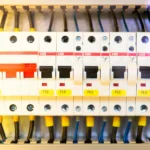Circuit breakers are the most important components in electrical systems, designed to protect circuits and equipment from overloads, short circuits, and other electrical faults. Circuit breakers come in a variety of forms, each with special characteristics and applications.
Types Of Circuit Breakers Used in Electrical System
Table Of Contents
- 1 Types Of Circuit Breakers Used in Electrical System
- 1.1 1. Miniature Circuit Breaker (MCB):
- 1.2 2. Molded Case Circuit Breaker (MCCB):
- 1.3 3. Residual Current Circuit Breaker (RCCB):
- 1.4 4. Residual Current Circuit Breaker with Overcurrent Protection (RCBO):
- 1.5 5. Air Circuit Breaker (ACB):
- 1.6 6. Vacuum Circuit Breaker (VCB):
- 1.7 7. Earth Leakage Circuit Breaker (ELCB):
- 1.8 8. Hydraulic-Magnetic Circuit Breaker:
- 1.9 9. High-Voltage Circuit Breaker:
- 1.10 10. Oil Circuit Breaker (OCB):
- 1.11 11. Gas-Insulated Circuit Breaker (GCB):
- 1.12 12. Remote-Controlled Circuit Breaker:
- 1.13 13. Ground Fault Circuit Interrupter (GFCI):
- 1.14 14. Arc Fault Circuit Interrupter (AFCI):
- 1.15 15. Ground Fault Protection Relay (GFPR):
- 1.16 16. Fuse:
- 1.17 17. Electronic Circuit Breaker:
- 1.18 18. Undervoltage Release (UVR) Circuit Breaker:
- 1.19 19. Shunt Trip Circuit Breaker:
- 1.20 20. Time-Delay Circuit Breaker:
- 1.21 21. Thermal-Magnetic Circuit Breaker:
- 1.22 22. Miniature Circuit Breaker with Energy Limitation (MCB-EL):
- 2 Conclusion:
- 3 FAQs: About Circuit Breakers
- 3.1 Q1: What is a circuit breaker?
- 3.2 Q2: What are the main types of circuit breakers?
- 3.3 Q3: What is the difference between MCBs and MCCBs?
- 3.4 Q4: How do RCCBs and GFCIs differ from each other?
- 3.5 Q5: What are AFCIs and how do they enhance safety?
- 3.6 Q6: Are there specialized circuit breakers for specific applications?
- 3.7 Q7: How do I choose the right circuit breaker for my application?
- 3.8 Q8: Can circuit breakers be reset after tripping?
- 3.9 Q9: How do I test the functionality of a circuit breaker?
- 3.10 Q10: Are there any maintenance requirements for circuit breakers?
1. Miniature Circuit Breaker (MCB):
- MCBs are commonly used in residential, commercial, and light industrial applications.
- They are compact in size and typically installed in electrical distribution panels.
- MCBs provide protection against overloads and short circuits and have fixed or adjustable trip settings.
- They are available in various current ratings and breaking capacities to suit different circuit requirements.
2. Molded Case Circuit Breaker (MCCB):
- MCCBs are larger and more robust than MCBs, designed for higher current and breaking capacity applications.
- They are commonly used in industrial and commercial installations to protect larger circuits and equipment.
- MCCBs have adjustable trip settings and provide protection against overloads, short circuits, and ground faults.
- They are available in various frame sizes and current ratings to accommodate different load requirements.
3. Residual Current Circuit Breaker (RCCB):
- RCCBs, also known as ground fault circuit interrupters (GFCIs), provide protection against electrical shock and ground faults.
- They detect imbalance in the current between the live and neutral conductors and trip the circuit if a fault is detected.
- RCCBs are commonly used in residential, commercial, and outdoor applications where electrical safety is critical.
- They are available in various sensitivity ratings and configurations, including two-pole and four-pole versions.
4. Residual Current Circuit Breaker with Overcurrent Protection (RCBO):
- RCBOs are devices that integrate the features of an MCB and an RCCB into one unit.
- They provide protection against both ground faults (residual current) and overcurrents (overloads and short circuits).
- RCBOs are commonly used in circuits where both types of protection are required, such as in residential and commercial installations.
- They are available in various current ratings, sensitivity levels, and configurations to meet different application requirements.
5. Air Circuit Breaker (ACB):
- ACBs are designed for high-current applications and offer robust performance and reliability.
- They use air as the arc extinguishing medium and are suitable for medium to large industrial installations.
- ACBs provide protection against overloads, short circuits, and ground faults and are often used in power distribution systems.
- They are available in various configurations, including fixed, drawout, and withdrawable types, to facilitate maintenance and servicing.
6. Vacuum Circuit Breaker (VCB):
- VCBs use a vacuum as the arc extinguishing medium and offer fast, reliable interruption of currents.
- They are commonly used in medium to high-voltage applications, such as power generation, transmission, and distribution.
- VCBs provide high breaking capacity, low maintenance requirements, and excellent performance under harsh environmental conditions.
7. Earth Leakage Circuit Breaker (ELCB):
- ELCBs, also known as ground fault circuit interrupters (GFCIs), are designed to protect against electrical shock caused by ground faults.
- They detect leakage currents to earth and trip the circuit if a fault is detected, thereby preventing electric shock hazards.
- ELCBs are commonly used in residential, commercial, and industrial installations where personnel safety is paramount.
8. Hydraulic-Magnetic Circuit Breaker:
- Hydraulic-magnetic circuit breakers combine the characteristics of thermal and magnetic trip mechanisms.
- They use a hydraulic delay mechanism for overload protection and a magnetic trip mechanism for short-circuit protection.
- Hydraulic-magnetic circuit breakers offer precise and consistent trip characteristics and are commonly used in sensitive equipment and critical applications.
9. High-Voltage Circuit Breaker:
- High-voltage circuit breakers are designed for use in power transmission and distribution systems operating at voltages above 1000 volts.
- They provide reliable interruption of high currents and are essential for protecting electrical grids and substations.
- High-voltage circuit breakers can use various arc extinguishing mediums, including air, oil, gas, and vacuum, depending on the application and voltage level.
10. Oil Circuit Breaker (OCB):
- Oil circuit breakers use mineral oil as an arc extinguishing medium and are typically used in medium-voltage applications.
- They offer reliable arc interruption and high breaking capacity and are commonly used in distribution networks, industrial plants, and power generation facilities.
- Oil circuit breakers require regular maintenance to ensure the proper level and quality of the insulating oil.
11. Gas-Insulated Circuit Breaker (GCB):
- Gas-insulated circuit breakers use sulfur hexafluoride (SF6) or other gases as an arc extinguishing medium.
- They are compact and provide excellent insulation properties, making them suitable for high-voltage applications where space is limited.
- Gas-insulated circuit breakers are commonly used in substations, power plants, and high-voltage transmission systems.
12. Remote-Controlled Circuit Breaker:
- Remote-controlled circuit breakers feature built-in communication and control capabilities, allowing for remote operation and monitoring.
- They can be controlled and monitored remotely using supervisory control and data acquisition (SCADA) systems, programmable logic controllers (PLCs), or other automation devices.
- Remote-controlled circuit breakers offer enhanced flexibility, convenience, and efficiency in managing electrical systems and troubleshooting faults.
13. Ground Fault Circuit Interrupter (GFCI):
- GFCIs are made to guard against ground faults, which happen when an electrical current accidentally travels through a human or water-filled passage and ends up on the ground.
- They stop electrical shock risks by spotting imbalances in the current between the hot and neutral conductors and tripping the circuit if a problem is found.
- GFCIs are commonly used in residential, commercial, and outdoor applications, such as bathrooms, kitchens, outdoor outlets, and construction sites.
14. Arc Fault Circuit Interrupter (AFCI):
- AFCIs are designed to protect against arc faults, which occur when electrical current flows through an unintended arc or spark between conductors.
- They detect the characteristic signatures of arcing events and trip the circuit if an arc fault is detected, thereby reducing the risk of electrical fires.
- AFCIs are commonly used in residential and commercial buildings to meet electrical safety codes and standards.
15. Ground Fault Protection Relay (GFPR):
- GFPRs are protective devices that detect ground faults and other electrical faults in power distribution systems.
- They provide sensitive and selective protection against ground faults by continuously monitoring the current flowing through the system and tripping the circuit if a fault is detected.
- GFPRs are commonly used in medium and high-voltage power systems, such as substations, industrial plants, and utility distribution networks.
16. Fuse:
- While not technically a circuit breaker, fuses serve a similar purpose in protecting electrical circuits from overloads and short circuits.
- Fuses consist of a thin strip of metal that melts when subjected to excessive current, thereby opening the circuit and interrupting the flow of electricity.
- Fuses are available in various types and ratings for different voltage and current applications, and they require replacement after they have operated.
17. Electronic Circuit Breaker:
- Electronic circuit breakers use solid-state electronic components, such as transistors and integrated circuits, to provide circuit protection.
- They offer fast and precise trip characteristics, adjustable settings, and advanced monitoring and diagnostic capabilities.
- Electronic circuit breakers are commonly used in sensitive electronic equipment, data centers, and critical infrastructure applications.
18. Undervoltage Release (UVR) Circuit Breaker:
- UVR circuit breakers are equipped with a release mechanism that trips the circuit when the voltage drops below a predetermined threshold.
- They are used to protect equipment from damage caused by low voltage conditions, such as motor stalling or voltage sag.
- UVR circuit breakers are commonly used in industrial and commercial applications where voltage stability is critical.
19. Shunt Trip Circuit Breaker:
- Shunt trip circuit breakers feature an additional coil that, when energized, causes the circuit breaker to trip instantaneously.
- They are used for remote tripping of the circuit breaker, such as in emergency shutdown systems or fire alarm circuits.
- Shunt trip circuit breakers are commonly used in commercial buildings, industrial facilities, and critical infrastructure installations.
20. Time-Delay Circuit Breaker:
- Time-delay circuit breakers feature an adjustable time delay mechanism that delays the opening of the circuit in response to overloads or short circuits.
- They are used to accommodate temporary overloads or inrush currents that are common during motor starting or equipment energization.
- Time-delay circuit breakers are commonly used in industrial motor circuits, HVAC systems, and equipment with high startup currents.
21. Thermal-Magnetic Circuit Breaker:
- Thermal-magnetic circuit breakers combine the characteristics of thermal and magnetic trip mechanisms to provide comprehensive protection against overloads and short circuits.
- They use a bimetal strip for thermal overload protection and a magnetic coil for short-circuit protection.
- Thermal-magnetic circuit breakers are commonly used in residential, commercial, and industrial applications where reliable protection is required.
22. Miniature Circuit Breaker with Energy Limitation (MCB-EL):
- MCB-ELs are designed to limit the amount of energy delivered to a fault during short-circuit conditions, thereby reducing the risk of equipment damage and electrical fires.
- They are equipped with special arc extinguishing chambers or energy-limiting components to absorb and dissipate the energy generated during a fault.
- MCB-ELs are commonly used in sensitive equipment, critical infrastructure, and high-risk environments.
Conclusion:
These are some of the main types of circuit breakers used in electrical systems, each offering specific features and benefits for different applications and voltage levels. The selection of the appropriate circuit breaker depends on factors such as the type of load, voltage rating, current rating, fault protection requirements, and environmental conditions.
FAQs: About Circuit Breakers
Q1: What is a circuit breaker?
A circuit breaker is a protective device designed to automatically interrupt electrical circuits in the event of overcurrent, short circuit, or ground fault conditions. It serves to protect electrical equipment, prevent damage to wiring, and mitigate the risk of electrical fires.
Q2: What are the main types of circuit breakers?
The main types of circuit breakers, including:
> Miniature Circuit Breakers (MCBs)
> Molded Case Circuit Breakers (MCCBs)
> Residual Current Circuit Breakers (RCCBs)
> Ground Fault Circuit Interrupters (GFCIs)
> Arc Fault Circuit Interrupters (AFCIs)
Q3: What is the difference between MCBs and MCCBs?
Miniature Circuit Breakers (MCBs) are designed for low-voltage applications and are typically used for residential and commercial electrical distribution systems. They have lower current ratings and are more compact in size compared to Molded Case Circuit Breakers (MCCBs), which are suitable for higher voltage and current applications such as industrial machinery and equipment.
Q4: How do RCCBs and GFCIs differ from each other?
Residual Current Circuit Breakers (RCCBs) and Ground Fault Circuit Interrupters (GFCIs) both provide protection against ground faults, but they operate differently. RCCBs detect imbalances in current between the live and neutral conductors, while GFCIs monitor the difference in current between the hot and neutral conductors. RCCBs are commonly used in Europe, while GFCIs are prevalent in North America.
Q5: What are AFCIs and how do they enhance safety?
Arc Fault Circuit Interrupters (AFCIs) are designed to detect and mitigate the risk of electrical fires caused by arcing faults in wiring or electrical devices. They monitor the electrical waveform for characteristic signatures of arcing and automatically trip the circuit breaker to interrupt power flow when detected, preventing potential fire hazards.
Q6: Are there specialized circuit breakers for specific applications?
Yes, there are specialized circuit breakers designed for specific applications, such as:
> Surge Protection Circuit Breakers: Provide protection against voltage surges and transient overvoltages.
> Solar PV Circuit Breakers: Specifically designed for photovoltaic (PV) systems to protect against overcurrent and fault conditions.
> Motor Circuit Protectors: Protect electric motors from overloads, short circuits, and phase unbalance.
Q7: How do I choose the right circuit breaker for my application?
When selecting a circuit breaker, consider factors such as the voltage and current rating of the circuit, the type of load being protected, the environment (indoor or outdoor), Consulting with a qualified electrician or engineer can help ensure the appropriate circuit breaker is chosen for your needs.
Q8: Can circuit breakers be reset after tripping?
Yes, most circuit breakers can be reset after tripping by manually switching them from the “OFF” to the “ON” position. However, it’s essential to investigate the cause of the trip and address any underlying issues, such as overloads or short circuits, before resetting the breaker to prevent recurrence of the fault.
Q9: How do I test the functionality of a circuit breaker?
Circuit breakers should be periodically tested to ensure proper operation. This can be done using a circuit breaker tester or by engaging the test button (if equipped) on the breaker itself. It’s important to follow manufacturer guidelines and safety precautions when testing circuit breakers to avoid electrical hazards.
Q10: Are there any maintenance requirements for circuit breakers?
Routine maintenance of circuit breakers may include visual inspections for signs of damage or wear, testing for proper functionality, and cleaning of contacts and terminals. Consult the manufacturer’s instructions and relevant standards for specific maintenance recommendations based on the type and application of the circuit breaker.






